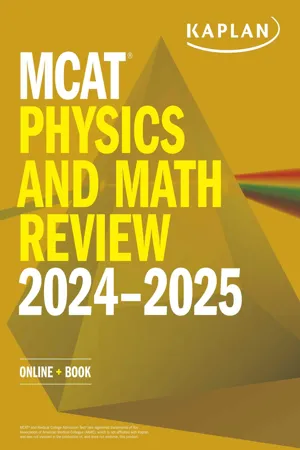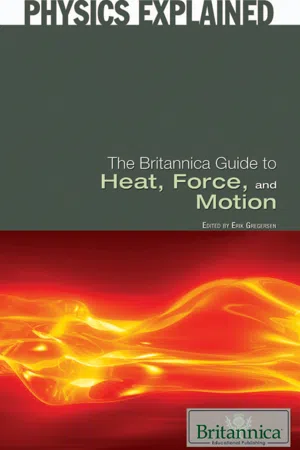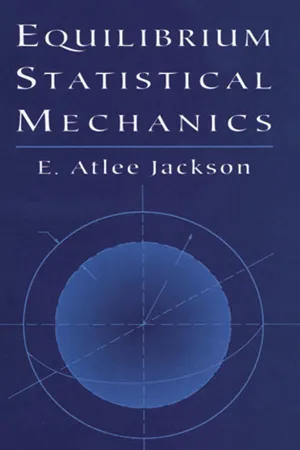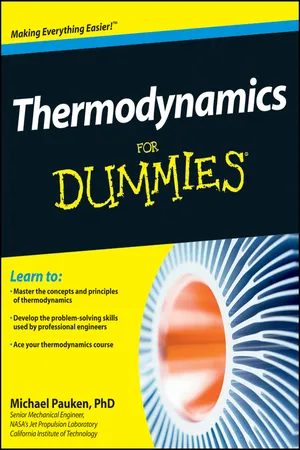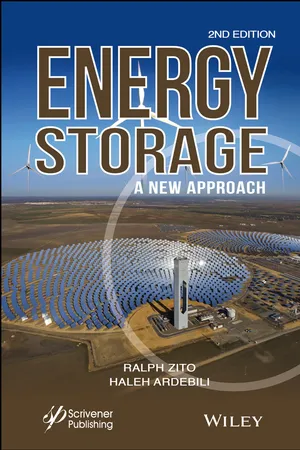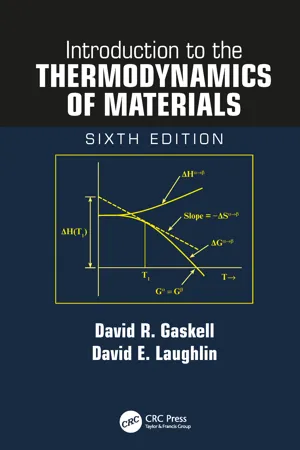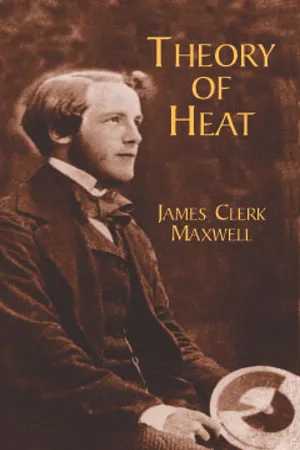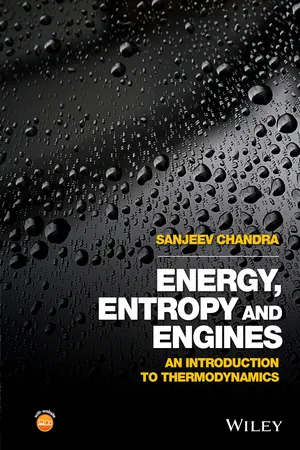Physics
Total Mechanical Energy
Total mechanical energy is the sum of an object's kinetic energy and potential energy. It represents the overall energy of a system due to its motion and position. In the absence of non-conservative forces like friction, the total mechanical energy of a system remains constant, following the principle of conservation of energy.
Written by Perlego with AI-assistance
Related key terms
Related key terms
1 of 4
Related key terms
1 of 3
9 Key excerpts on "Total Mechanical Energy"
- No longer available |Learn more
MCAT Physics and Math Review 2024-2025
Online + Book
- (Author)
- 2023(Publication Date)
- Kaplan Test Prep(Publisher)
elastic potential energy, which can be determined byU =Equation 2.31 2kx 2where U is the potential energy, k is the spring constant (a measure of the stiffness of the spring), and x is the magnitude of displacement from equilibrium. Note the similarities between this equation and the formula for kinetic energy.Total Mechanical Energy
The sum of an object’s potential and kinetic energies is its Total Mechanical Energy. The equation isE = U + KEquation 2.4where E is Total Mechanical Energy, U is potential energy, and K is kinetic energy. The first law of thermodynamics accounts for the conservation of mechanical energy, which posits that energy is never created nor destroyed—it is merely transferred from one form to another. This does not mean that the Total Mechanical Energy will necessarily remain constant, though. You’ll notice that the Total Mechanical Energy equation accounts for potential and kinetic energies but not for other forms of energy, such as thermal energy that is transferred as a result of friction (heat). If frictional forces are present, some of the mechanical energy will be transformed into thermal energy and will be “lost”—or, more accurately, dissipated from the system and not accounted for by the equation. Note that there is no violation of the first law of thermodynamics, as a full accounting of all the forms of energy (kinetic, potential, thermal, sound, light, and so on) would reveal no net gain or loss of total energy, but merely the transformation of some energy from one form to another.Conservation of Mechanical Energy
In the absence of nonconservative forces, such as frictional forces, the sum of the kinetic and potential energies will be constant. Conservative forces are those that are path independent and that do not dissipate energy. Conservative forces also have potential energies associated with them. On the MCAT, the two most commonly encountered conservative forces are gravitational and electrostatic. Elastic forces can also be approximated to be conservative in many cases, although the MCAT may include spring problems in which frictional forces are not - eBook - ePub
Biomechanics of Dance
Applications of Classical Mechanics
- Melanie Lott(Author)
- 2023(Publication Date)
- De Gruyter(Publisher)
isolated system is one in which no energy is exchanged between the system and environment (anything not included in the system). The entire universe is an isolated system, so the universe’s total energy remains fixed. When analyzing human movement, our system will not include the entire universe however, so we can not necessarily assume the system is isolated for all cases.Even after defining a system, the forms that energy takes can constantly change within that system. Keeping track of all the types of energy within a system and how much energy is transferred into or out of the system becomes one big accounting problem. Students of introductory physics, like the tennis playing dancer, are most familiar with two types of energy: kinetic (energy of motion) and potential (stored energy), and the total mechanical energy of a system is the sum of its kinetic and potential energies ().E mech= K + UIntroductory physics students may also encounter the idea of a more mysterious “internal energy.” For example, if a book falls toward the ground, the kinetic energy of the book-Earth system increases as the gravitational potential energy decreases, with the Total Mechanical Energy remaining constant (neglecting air resistance). However, when the book hits the ground, it comes to rest and mechanical energy is “lost.” Energy just can’t disappear, so where did it go? Some goes to sound energy as an audible “thud” is created; however, most of the mechanical energy is transferred to internal energy. More precisely, the collision jostles the molecules of the book and ground, increasing their random, microscopic motion. This internal energy is really a thermal energy, and as it increases, the temperature of the book and ground also increase, even if just slightly. - eBook - ePub
- Britannica Educational Publishing, Erik Gregersen(Authors)
- 2010(Publication Date)
- Britannica Educational Publishing(Publisher)
Although classical thermodynamics deals exclusively with the macroscopic properties of materials—such as temperature, pressure, and volume—thermal energy from the addition of heat can be understood at the microscopic level as an increase in the kinetic energy of motion of the molecules making up a substance. For example, gas molecules have translational kinetic energy that is proportional to the temperature of the gas: the molecules can rotate about their centre of mass, and the constituent atoms can vibrate with respect to each other (like masses connected by springs). Additionally, chemical energy is stored in the bonds holding the molecules together, and weaker long-range interactions between the molecules involve yet more energy. The sum total of all these forms of energy constitutes the total internal energy of the substance in a given thermodynamic state. The total energy of a system includes its internal energy plus any other forms of energy, such as kinetic energy due to motion of the system as a whole (e.g., water flowing through a pipe) and gravitational potential energy due to its elevation.THE FIRST LAW OF THERMODYNAMICS
The laws of thermodynamics are deceptively simple to state, but they are far-reaching in their consequences. The first law asserts that if heat is recognized as a form of energy, then the total energy of a system plus its surroundings is conserved; in other words, the total energy of the universe remains constant.The first law is put into action by considering the flow of energy across the boundary separating a system from its surroundings. Consider the classic example of a gas enclosed in a cylinder with a movable piston. The walls of the cylinder act as the boundary separating the gas inside from the world outside, and the movable piston provides a mechanism for the gas to do work by expanding against the force holding the piston (assumed frictionless) in place. If the gas does work W as it expands, and/or absorbs heat Q from its surroundings through the walls of the cylinder, then this corresponds to a net flow of energy W - Q across the boundary to the surroundings. In order to conserve the total energy U , there must be a counterbalancing changein the internal energy of the gas. The first law provides a kind of strict energy accounting system in which the change in the energy account (ΔU ) equals the difference between deposits (Q ) and withdrawals (W - eBook - ePub
- E. Atlee Jackson(Author)
- 2012(Publication Date)
- Dover Publications(Publisher)
models (simplified pictures) of atoms, molecules, gases, and solids will illustrate the various types of interactions between particles. Finally, we shall consider some of the important modifications of these classical models that are required by quantum mechanics.2. KINETIC AND POTENTIAL ENERGY
To begin with, let us consider a particle moving in space as it is described in classical mechanics. The position of the particle r (t ) = x (t )i + y (t )j + z (t )k [where (i, j, k ) are the unit vectors in the (x , y , z ) directions] generally varies in time and has a velocityIf the particle has a mass m, it is said to have a kinetic energy (sometimes called the translational energy )(1)If a force F acts on the particle, its velocity will change according to Newton’s law(2)If no force acts on the particle, then it follows from Equation (2) that v is independent of the time, and consequently the kinetic energy is also a constant. We can also see this from the fact that(3)which vanishes if F vanishes.Now the force that acts on the particle generally depends on the position of the particle r and sometimes also on the velocity (e.g., frictional forces, or the force on a charged particle moving in a magnetic field). If the force depends only on r and if it can be expressed in terms of the gradient of some function Φ - eBook - ePub
- Mike Pauken(Author)
- 2011(Publication Date)
- For Dummies(Publisher)
is one of the strongest forms of molecular energy because it’s associated with the nucleus of an atom. This energy form isn’t discussed in thermodynamics at this level, but at least you know it exists.Calculating total energy
The total amount of energy that a system contains includes both the macroscopic and microscopic forms of energy associated with it. The following equations for total energy sum up the kinetic, potential, and internal energies. The extensive form of the total energy of a system includes the mass of the system in each energy component. The intensive form is on a per unit mass basis.E = KE + PE + U = 1⁄2m · V 2 + m · g · z + m · u (extensive form)e = ke + pe + u = 1⁄2V 2 + g · z + u (intensive form)Nearly every thermodynamic analysis uses one of these two equations. You use them to determine the amount of energy that occurs in the form of work and heat for many thermodynamic processes. Because chemical and nuclear energy aren’t usually dealt with in introductory thermodynamics, these forms of energy are omitted from the equations calculating the total energy of a system.Enthalpy
Many thermodynamic processes involve a fluid flowing through a device and undergoing a change in internal energy. Any time a fluid flows into a system, it does work on the system, and any time a fluid flows out of a system, the system does work on the fluid. This occurs when hot water flows though an automobile radiator, for example. The work associated with the fluid flowing into or out of the system is represented by the product of the pressure (P ) and the volume (V ) of the fluid. This happens in so many situations that a new property, enthalpy (H ), is used to combine the change in internal energy with this flow work, to make calculations more convenient. Enthalpy is defined by the following equation: H = U + PV. The units for enthalpy are the same as those for internal energy. The units for the pressure-volume (PV ) product in the SI system are kilopascals-cubic meter (kPa · m3 - eBook - ePub
Energy Storage
A New Approach
- Ralph Zito, Haleh Ardebili(Authors)
- 2019(Publication Date)
- Wiley-Scrivener(Publisher)
The history of the development of physical concepts is not the prime concern here, but some knowledge of their evolution does serve to bring more closely to our attention and scrutiny a better appreciation of terms that we employ daily. Sometimes it is necessary to begin understanding or developing a body of knowledge in order to make certain basic assumptions on an entirely intuitive basis. As scientifically unsatisfying as that may be, it is unavoidable at times. One could draw a weak comparison to plane geometry (Euclid) with regard to its various axioms and the declaration that parallel lines never meet. Even the concept of straight lines is rather intuitive in nature.Perhaps the best definition is that a force is required to change the motion of a body. Many problems arise in finding acceptable definitions for the basic parameters of physical science, namely, the abstract concepts of mass, time, force, and energy. However, we must learn to be satisfied with definitions that leave something to be desired in order to move on toward generating a working body of mechanics that enables us to design and build practical devices that serve our purposes.An interesting definition of energy comes from the Grolier Encyclopedia, which states:Energy can be measured in terms of mechanical work, but because not all forms of energy can be converted into useful work, it is more precise to say that the energy of a system changes by an amount equal to the net work done on the system … In classical physics, energy, like work, is considered a scalar quantity; the units of energy are the same as those of work. These units may be ergs, joules, watt-hours, foot-pounds, or foot-poundals, depending on the system of units being used. In modern science, energy and the three components of linear momentum are thought of as different aspects of a single four-dimensional vector quantity, much as time is considered to be one aspect of the four-dimensional space-time continuum … Energy exists in many different forms. The form that bodies in motion possess is called kinetic energy. Energy may be stored in the form of potential energy, as it is in a compressed spring. Chemical systems possess internal energy, which can be converted by various devices into useful work; for example, a fuel such as gasoline can be burned in an engine to propel a vehicle. Heat energy may be absorbed or released when the internal energy of a system changes while work is done on or by the system. (1993) - eBook - ePub
- David R. Gaskell, David E. Laughlin(Authors)
- 2017(Publication Date)
- CRC Press(Publisher)
2 The First Law of Thermodynamics 2.1INTRODUCTIONThe First Law of Thermodynamics is sometimes thought to be merely an extension to the Law of Conservation of Energy, which was discovered in the late seventeenth century for mechanical systems. It is, however, much more! The First Law introduces the important thermodynamic state variable internal energy , U (also called a thermodynamic potential ), and the law posits that energy may be converted from one of its forms to another form. Furthermore, the law introduces the important concept that the transfer of thermal energy (heat) is a different kind of energy than that which is done during a process of work . First, we start with a review of basic mechanics.Kinetic energy is conserved in a frictionless system of interacting rigid elastic bodies. A collision between two of these bodies results in a transfer of kinetic energy from one to the other; the work done by the one equals the work done on the other. The total kinetic energy of the system is unchanged as a result of the collision. If the kinetic system is in the influence of a gravitational field, then the sum of the kinetic and potential energies of the bodies is constant. Changes of position of the bodies in the gravitational field, in addition to changes in the velocities of the bodies, do not alter the total dynamic energy of the system. As the result of possible interactions, kinetic energy may be converted to potential energy and vice versa, but the sum of the two remains constant. If, however, friction occurs in the system, then with continuing collision and interaction among the bodies, the total dynamic energy of the system decreases and thermal energy is produced. It is thus reasonable to expect that a relationship exists between the dynamic energy dissipated and the thermal energy produced as a result of the effects of friction.The establishment of such a relationship laid the foundations for the development of the thermodynamic method. As a subject, this has now gone far beyond simple considerations of the interchange of energy from one form to another—for example, from dynamic energy to thermal energy. The development of thermodynamics from its early beginnings to its present state was achieved as the result of the invention of convenient thermodynamic functions of state . In this chapter, the first two of these thermodynamic functions—the internal energy , U , and the enthalpy , H - eBook - ePub
- (Author)
- 2012(Publication Date)
- Dover Publications(Publisher)
Combining this with the other conditions, that the volume is unchanged, and that the final state with respect to pressure and temperature is common to all the bodies, we may determine the final value of the temperature, pressure, and total entropy.The total entropy will now have the maximum value consistent with the original state of the system. The dissipation of the available energy will be complete.MECHANICAL AND THERMAL ANALOGIES.
In studying thermodynamics we may find considerable assistance from a comparison between the thermal and the mechanical phenomena.We have to do with energy in two forms, work and heat. When energy is being transferred from one body to another we can always tell whether the first body is doing mechanical work on the second or communicating heat to it. Work is done by motion against resistance. Heat is communicated from a hotter to a colder body.But as soon as the energy has entered the second body, we can no longer distinguish by any legitimate process whether it is in the form of work or of heat. In fact we may remove it from the body under either of these forms.If a fluid at a pressure p increases in volume from v to v‘, it performs work against external resistance, the amount of which work isp (v ’− v ) = w .If a body at temperature θ increases in entropy from φ to φ‘ , an amount of heat must have entered it represented byθ ·(φ − φ ) = H.If both these processes take place, and if the energy of the body is thereby changed from E to E‘, thenE’ − E = H − W = θ (φ ’ − φ ) − p (v ’ − v ).Here then we have two sets of quantities, one relating to work, the other to heat.
Of these quantities Work and Heat are simply two forms of Energy.w v p H φ θ The volume is a quantity such that without a change of Its value no work can be done. The amount of work done, however, is measured, not by the change of volume alone, but by that change multiplied by another quantity—the pressure.In the same way the entropy is a quantity such that without a change in its value no heat can enter or leave the body. The amount of this heat, however, is not measured by the change of entropy, but by that change multiplied by another quantity—the absolute temperature. - eBook - ePub
Energy, Entropy and Engines
An Introduction to Thermodynamics
- Sanjeev Chandra(Author)
- 2016(Publication Date)
- Wiley(Publisher)
2 Concepts and Definitions In this chapter you will: Review the fundamentals of Newtonian mechanics, including mechanical work, kinetic and potential energy. Identify various types of thermodynamic systems such as open, closed and isolated systems. Define thermodynamic properties. Distinguish equilibrium from steady state. Classify different types of equilibrium including mechanical, thermal and phase equilibrium. Learn about thermodynamic states, processes and cycles. Become familiar with problem solving methods in thermodynamics. 2.1 Fundamental Concepts from Newtonian Mechanics How do you describe colours to someone who cannot see? Some ideas are so fundamental that the only way to grasp them is to use your own senses. All sciences are based on a small number of concepts that have to be understood intuitively before it is possible to conduct any meaningful discussion. In Newtonian mechanics there are three fundamental concepts that cannot be explained in terms of simpler ideas – we have to experience them ourselves to know what they are. These three concepts are: length, mass and time. 2.1.1 Length All physical objects occupy space. We specify the size of a body in any one dimension by measuring its length (L). Since length is a fundamental concept, it is measured using arbitrarily defined units. In the International System of units that we use (abbreviated as SI from its French title, Système Internationale) the unit of length is the metre (m). The metre was initially defined in 1799, when the distance between the pole and the equator of the Earth, measured along a line of longitude, was specified to be 10 million metres. A one-metre long platinum bar was made and kept in a vault in Paris and used as a standard
Index pages curate the most relevant extracts from our library of academic textbooks. They’ve been created using an in-house natural language model (NLM), each adding context and meaning to key research topics.
Explore more topic indexes
Explore more topic indexes
1 of 6
Explore more topic indexes
1 of 4
